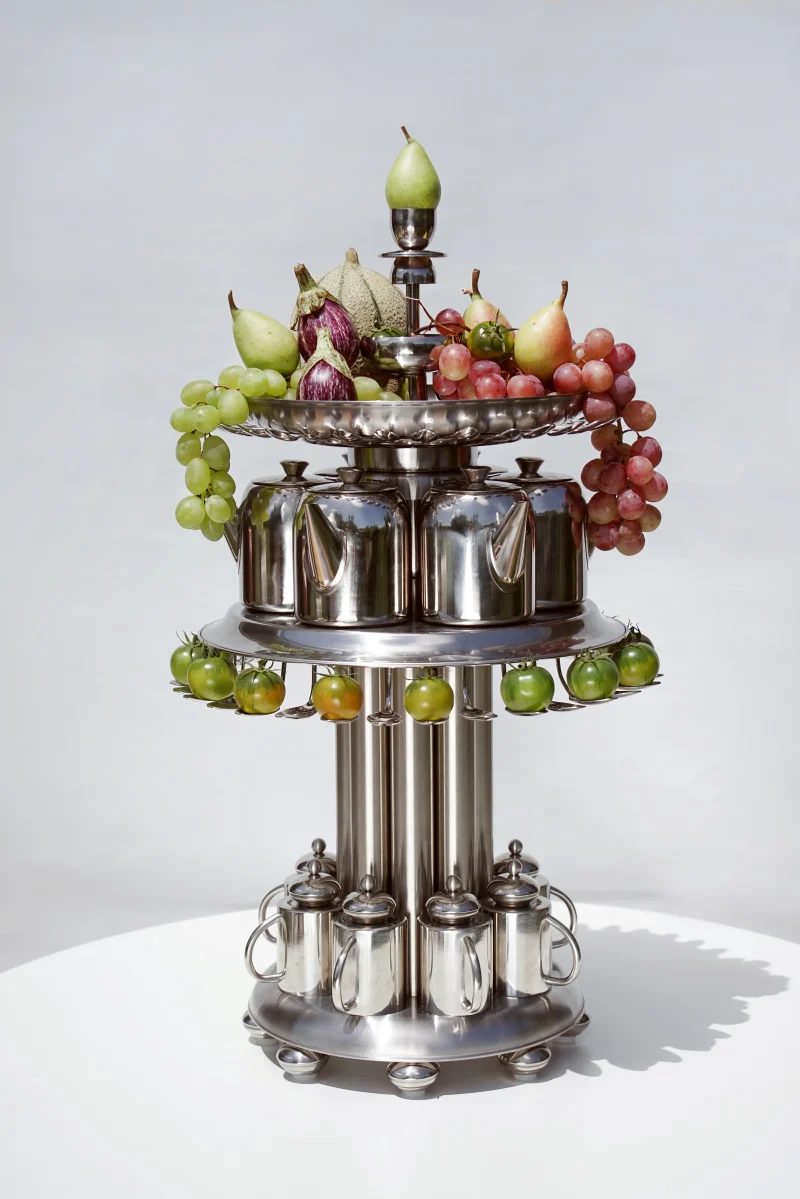“In Praise of Folly”: COLLECTIBLE 2025 Blurs Function and Delight
Parabán, MDF, aluminum, 2025. Designed by Maria Laura Camejo. Courtesy of Concordia Studio
Last week, COLLECTIBLE Design Fair returned to New York for its sophomore showing in the city (its eighth year overall since launching Brussels in 2017). From September 4–7, the fair took over the entire 36th floor of Water Street Projects (WSA), bringing together 123 exhibitors from 22 countries across six curatorial sections: MAIN, BESPOKE, FASHION, NEW GARDE, CURATED, AND VIGNETTE.
Timed to Armory Week, when New York’s cultural calendar roars back after Labor Day, COLLECTIBLE unfolded alongside Independent 20th Century, Future Fair, and the new Duet group show, also staged in WSA.
Described as the foremost global platform for collectible contemporary design, COLLECTIBLE 2025 shifted tone as well as scaling up: leaning into performance, immersion, and discussions of the social life of objects, as well as an ethos celebrating how they can help us access pure delight.
CURATED
Co-founded by Liv Vaisberg (formerly director of Independent Brussels) and Clélie Debehault, COLLECTIBLE bridges gallery and marketplace. Vaisberg told The Art Newspaper that “all of the objects are limited editions of twelve or fewer, and most are unique pieces,” emphasizing that the fair is meant to be more than a trade show—rather, a “curated and designer-centered fair” fostering collaboration and exchange.
This was visible in this year’s CURATED section, titled In Praise of Folly and organized by Architectural Digest senior editor Hannah Martin and scenographer Cat Snodgrass. Its concept drew from architectural follies: ornamental structures designed to delight and provoke but with little or no practical purpose. A standout was Italian studio Touch With Eyes’s fantastical A Mad Tea Party, a tower constructed entirely from stainless steel teapots, teaspoons, saucers, and other tea party essentials. Functionally ambiguous (the catalogue notes that its function is “pure amusement,” although it might be used as “storage for small treasures”). It evokes both the proportions of a classical column and the irrationality of Alice in Wonderland, merging craft with absurd theatre in a winking tribute to beloved rituals.
Image: Touch with Eyes, A Mad Tea Party
FROM DESIGN TO PERFORMANCE
Beyond last year’s breadth of exhibitors, 2025 expanded its scope through immersive and performative programming.
Opening-night performance Distant Family Dinner invited guests to sit at a table designed by two dozen designers while sharing an eleven-course meal by New York chef Marissa Lippert. Over time, each guest’s seat was gradually separated from the table, fracturing the communal setting.
Image: Place setting for A Distant Family Dinner. Photo by Simon Leung
First gradually, then suddenly, the choreography quickly overshadowed the meal: diners defended their plates with outstretched arms, wielding comically long forks—what felt like nearly four feet in length. The result was a less communal feast than allegory—an absurdist performance about scarcity, competition and desire. (I did catch one impeccably dressed guest, sunglasses on after dark, calmly sitting down to enjoy her meal amid the surrounding chaos, as a lit candlestick clattered to the floor across the table from her.)
Elsewhere, Bond Hardware offered piercings on-site, making the body a site for collectible design. Additionally, public programming expanded with panels such as Designing Legacy: The New Heirlooms, Community Building in Design, and Transdisciplinary Aesthetics, alongside masterclasses and private tours.
OTHER ART CURRENTLY FAVORITES
Concordia Studio: Venezuelan-born designer Maria Laura Camejo reimagined foundational objects from her childhood home—a trunk, a rocking chair, a room divider—once made in wood, now rendered in metal. I found her translation of embroidered motifs into metal particularly striking, the effect translating softness and texture into a sleek permanence.
Playinghouse’s Silver Tablecloth – Idea for a Table used negative cut-outs to cast playful shadows across the floor, turning light into gesture. Appropriately for the studio’s name, the piece was playful, reflecting how simple tools (cut-outs, light, shadow) can transform functional furniture into a catalyst for reverie and imagination.
Thousand Flower Shop, a collaboration between New York-based Tang Thousand and Czech designer Lucie Claudia Podrabska, presented delicate glassworks paying homage to Chinatown’s ubiquitous flower stand and their classic yellow awnings—a nostalgic nod to urban vernacular, combining local memory and nostalgia with craftsmanship.
TAKEAWAYS
Across the fair, a few themes stood out: playfulness as a serious design language, from comically long forks to shadow-casting tables; deep respect for craftsmanship and materials in works of glass, metal, and textile; a sensitivity to cultural memory and migration; and an embrace of performance and immersion. Together, these threads marked COLLECTIBLE’s sophomore New York edition as more ambitious, chaotic, and exuberant than its 2024 debut.For context, revisit Surface magazine’s coverage of 2024’s launch, and then compare it to 2025’s feverish, playful, sometimes chaotic edition, which proved COLLECTIBLE is a stage where design performs, provokes, and delights.




 Simon Leung.webp)
